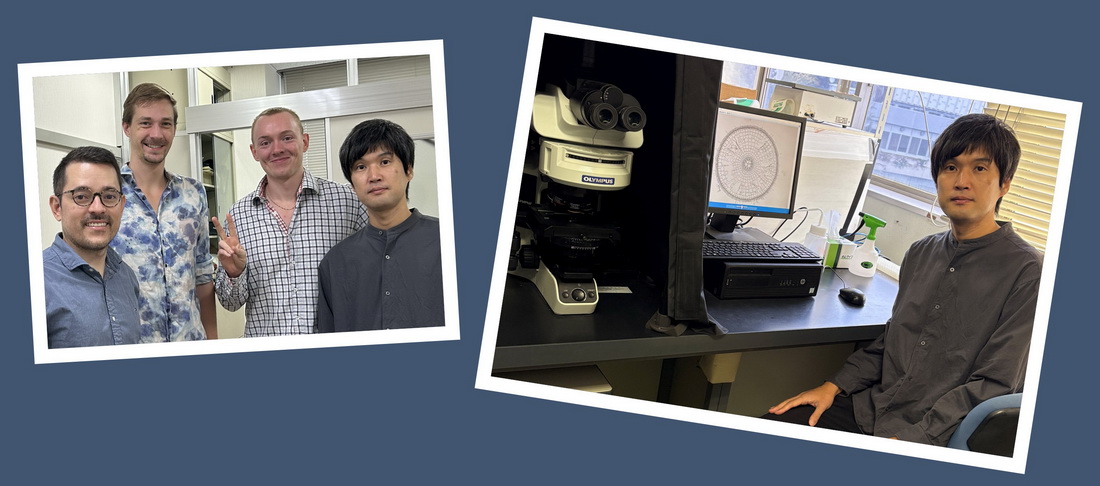Root traits controlling CH₄ emissions from rice
Rice farming is one of the world’s largest human-made sources of greenhouse gases. To achieve high yields, farmers rely on irrigation and fertilizer. But these practices, combined with natural processes in the soil, create large amounts of carbon dioxide (CO₂), methane (CH₄), and nitrous oxide (N₂O).

Prof. Takaki Yamauchi hosted Juan, Tobias, and Albert during two weeks of work in his laboratory. He had prepared everything in advance, including the plant cultures for the experiments, which made the research visit very successful.
Our research suggests that new rice varieties could be developed with special root traits to help limit these emissions. For example, rice roots with large internal air channels (aerenchyma) can move oxygen more effectively inside the plant. If oxygen is transported deeper into the soil, it creates “oxygen hotspots” around the roots. In these zones, microbes use the oxygen to convert methane into carbon dioxide and to improve nitrogen cycling, both of which reduce greenhouse gas release while also supporting better plant nutrition.
Another important trait is the formation of tight barriers in the root that prevent oxygen from leaking out too early. These barriers not only direct oxygen to where it is most needed but also make it harder for methane from the soil to enter the plant and escape into the air.
Jiménez JdlC, Noorrohmah S, Suresh K, Zeisler-Diehl VV, Peralta Ogorek LL, Herzog M, Pellegrini E, Nagai K, Ashikari M, Takahashi H, Pedersen O, Schreiber L, Nakazono M (2024) Leaf Gas Film 1 promotes glycerol ester accumulation and formation of a tight root barrier to radial O2 loss in rice. Plant Physiology. doi: 10.1093/plphys/kiae458.
Jiménez JdlC, Pedersen O (2023) Mitigation of greenhouse gas emissions from rice via manipulation of key root traits. Rice 16: 24. doi: 10.1186/s12284-023-00638-z.
Jiménez JdlC, Pellegrini E, Pedersen O, Nakazono M (2021) Radial oxygen loss from plant roots - methods. Plants 10: 2322. doi: 10.3390/ plants10112322.
Peralta Ogorek LL, Jiménez JdlC, Visser EJW, Takahashi H, Nakazono M, Shabala S, Pedersen O (2024) Outer apoplastic barriers in roots: prospects for abiotic stress tolerance. Functional Plant Biology 51: FP23133. doi: 10.1071/FP23133.
Yamauchi T, Pedersen O, Nakazono M, Tsutsumi N (2021) Key root traits of Poaceae for adaptation to soil water gradients. New Phytologist 229: 3133-3140. doi: 10.1111/nph.17093.
Yamauchi T, Colmer TD, Pedersen O, Nakazono M (2018) Regulation of root traits for internal aeration and tolerance to soil waterlogging-flooding stress. Plant Physiology 176: 1118-1130. doi: 10.1104/pp.17.01157.
We collaborate with Drs. Amelia Henry and Ando Radanielson at the International Rice Research Institute in the Philippines through the project REMET, where the field testing of our hypotheses will take place.
Dr. Takaki Yamauchi at Nagoya University is also a key collaborator thanks to his experimental facilities and access to rice mutants that differ in the root traits we study, such as the outer apoplastic root barrier, root aerenchyma, and the number of lateral roots.
Contact
Professor Ole Pedersen, PI, ORCID
Funded by
This collaboration is funded through a consultancy engagement with the International Rice Research Institute under their REMET project, as well as by a strategic grant from the Department of Biology, UCPH. The project is expected to run until the end of 2027.
